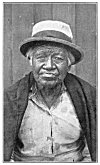
Sacred Texts Native American California Index Previous Next

The Yosemites and all of the other tribes named in the previous chapter were put upon the Fresno reservation. Major Savage, who had been the leading figure in the war against the Indians, was perhaps their best friend while in captivity, and finally lost his life in a personal quarrel, while resenting a wrong which had been committed against them.
The tribes from south of the San Joaquin River, who were also conquered in 1851, were put upon the kings River and Tejon (Tay-hone') reservations.
Ample food supplies, blankets, clothing and cheap fancy articles were furnished by the Government for the subsistence, comfort, and pleasure of the Indians on the reservations, and for a short time they seemed to be contented, and to enjoy the novelty of their new mode of life. The young, able-bodied men were put to work assisting in
clearing, fencing and cultivating fields for hay and vegetables, and thus they were partially self-supporting. A large portion of them, however, soon began to tire of the restraints imposed, and longed for their former condition of freedom, and many of them sickened and died.
Old Teneiya, chief of the "Grizzlies," was particularly affected by the change in his surroundings, and by the humiliation of defeat. He suffered keenly from the hot weather of the plains, after his free life in the mountains, and begged to be allowed to return to his old home, promising not to disturb the white settlers in any way, a pledge which he did not break.
Teneiya was finally allowed to depart, with his family, after having been on the reservation only a few months, and some of his old followers afterwards stole away and joined him. With this remnant of his band he returned to the Yosemite, but not long afterwards they were set upon by the Monos, a tribe from the eastern side of the Sierras, with whom they had quarreled, and the old chief and many of his warriors were
killed. It was perhaps fitting that he should meet his death in the valley which he loved, and which he had so long defended against his enemies.
In 1855, after four years of confinement on the reservations, an agreement was made with the Indian Commissioners, by the head men of the tribes, that if their people were again allowed their freedom, they would forever remain in peace with the white settlers, and try and support themselves free of expense to the Government. They were soon permitted to leave, and have ever since faithfully kept their promise.
Most of them went back to the vicinity of their old homes, and made temporary settlements on unoccupied Government land, as many of their old village sites were now in possession of white settlers. As there was a very large crop of acorns that season, they gathered an abundant supply for winter use, and, with what was given to them in the way of food and clothing by some of the white settlers, they managed to get through the winter fairly well.

Click to enlarge
CAPTAIN PAUL.
One of the characters of the Valley. Supposed to be at least 105 years old, and a survivor of Teneiya's band.
Their four years' residence on the reservations, however, had been more of a school in the vices of the whites than one of a higher education. They became demoralized socially, addicted to many bad habits, and left the reservations in worse condition than when they were taken there. Their old tribal relations and customs were nearly broken up, though they still had their head men to whom they looked for counsel in all important matters.
As the country became more settled, much of their main food supply, the acorns, was consumed by the domestic animals of the ranchers, and their mode of living became more precarious and transitory, and many of them were, at times, in a condition near to starvation. In these straitened and desperate circumstances, many of their young women were used as commercial property, and peddled out to the mining camps and gambling saloons for money to buy food, clothing or whisky, this latter article being obtained through the aid of some white person, in violation of law.
Their miserable, squalid condition of living opened the way for diseases of a malignant character, which their medicine men could not cure, and their numbers were rapidly reduced by death.
At the present time there are not in existence a half-dozen of the old Yosemites who were living, even as children, when the Valley was first discovered in 1851; and many of the other tribes have been correspondingly reduced.